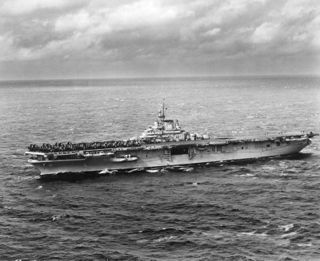Rotgeheim-class aircraft carrier
|
RKM Kirchmeyer off the coast of Rotgeheim, mid-1910 | |
| Class overview | |
| Name | Rotgeheim |
| Namesake | Rotgeheim |
| Builder | Rotgeheime Werke |
| Operators | |
| Preceded by | None |
| Succeeded by | Steinweg-class aircraft carrier |
| Built | 1904 – 1908 |
| In commission | 1905 – present |
| Completed | 5 |
| General characteristics | |
| Type | Aircraft carrier |
| Displacement | 42,120 tons |
| Length | 1,150 ft (350.2 m) |
| Beam | 315 ft (96 m) |
| Height | 280 ft (85.34 m) |
| Installed power | Three A1B nuclear reactors |
| Propulsion | Four shafts |
| Speed | 30 knots (56 km/h; 35 mph) |
| Range | Unlimited distance; 30 years |
| Complement | 5,270 |
| Aircraft carried | More than 100 |
| Aviation facilities | 1,092 ft x 256 ft (333 m x 78 m) flight deck |
The Rotgeheim class are one of the few classes of aircraft carrier utilized by the Navy of Rotgeheim. An order for four was issued in 1904, with the lead ship of its class produced in 1905 and the other three finished by 1908. The class itself is named after the country of origin as a testament to its self-given aura of success and respect. The class is known for being large, as the only ships larger than these in the arsenal of Rotgeheim are the Hornung-class battleships in service. These gargantuan vessels are usually present in all conflicts involving Rotgeheim, as their large complement of aircraft is invaluable to winning an engagement. After the successes of the Rotgeheim-class aircraft carriers during the 10 Days War, Northern Prussia (an ally of Rotgeheim) purchased a single aircraft carrier.
Background
The building of the Navy in the late 1890s and 1900s saw the creation of a multitude of warfaring vessels. As the Navy of Rotgeheim grew more powerful, the Navy Chiefs of Staff looked toward expanding even more upon its strength. The Hornung-class battleships are one such example of the expansion. In June 1904, Kaiser Florian I issued an order of four large aircraft carriers to one of the most renown shipbuilders in Rotgeheim and internationally, Rotgeheime Werke. The first drafts and concept designs for the aircraft carrier class were produced in August of 1904. The Kaiser appreciated the designs given and gave the go-ahead to begin production later that month.
Design
Flight Deck
When drawing up the designs for the Rotgeheim-class, particular attention was paid towards the flight deck. Several nations in other conflicts had won decisive engagements with aircraft carriers, and many of the ships utilized were equipped with large flight decks. More takeoff space was envisioned, along with specializes support structures to allow heavier aircraft to take off. The accepted design for the flight deck was a total length of 1,092 feet by 256 feet.
Hangar Deck
As with the flight deck, the hangar deck was designed with more space in mind. The heavier aircraft of modern times required ample space for loading and storage. The designers of the Rotgeheim-class created specialized support structures both for the flight deck and hangar deck to allow for heavier aircraft to be stored, loaded, and finally take off. Not only were the supporting structures to the hangar and flight decks required to carry the increased weight of landing and parked aircraft, but they were to have sufficient strength to support the storing of spare fuselages and parts (50% of each plane type aboard) under the flight deck and still provide adequate working space for the men using the area below.
Ships
The following ships are the produced and actively-serving Hornung-class battleships. Hull numbers are the letter and number designation given to each ship, apart from its actual ceremonial name. Aircraft carriers in the Rotgeheiman Navy begin their hull number designations with "FT", representing Flugzeugträger ("Aircraft Carrier"). Ships in the Navy of Northern Prussia, unlike their Rotgeheiman counterparts, do not have hull numbers, and as such they are not listed.
| Name | Hull number | Builder | Laid down | Launched | Country | Unit | Captain |
|---|---|---|---|---|---|---|---|
| RKM Rotgeheim | FT-001 | Rotgeheime Werke | 30 August 1904 | 12 September 1905 | Rotgeheim | 1st Fleet, Kriegsmarine | Wolfgang Eichinger |
| RKM Kirchmeyer | FT-002 | Rotgeheime Werke | 28 December 1905 | 8 December 1906 | Rotgeheim | 1st Fleet | Leonard Staudinger |
| RKM Seelow | FT-003 | Rotgeheime Werke | 12 December 1906 | 4 December 1907 | Rotgeheim | 1st Fleet | Thorsten Amsel |
| RKM Güstrow | FT-002 | Rotgeheime Werke | 18 December 1907 | 3 December 1908 | Rotgeheim | 1st Fleet | Sigmund Fechter |
| RS Preußen Glory | Rotgeheime Werke | 5 March 1913 | 2 January 1914 | Northern Prussia | 1st Fleet, Reichsmarine |

